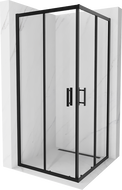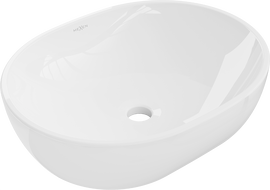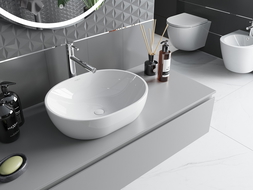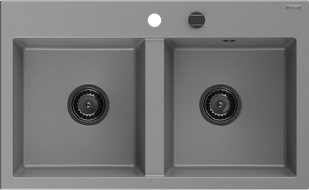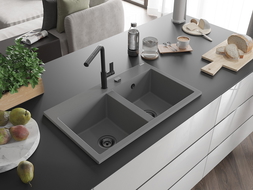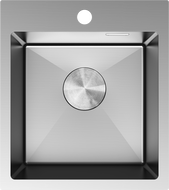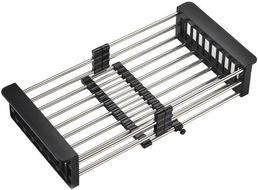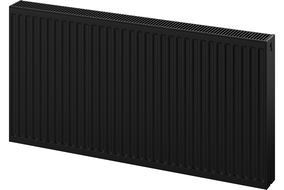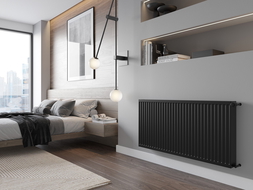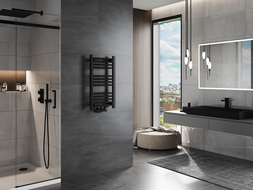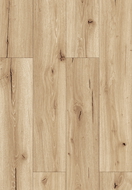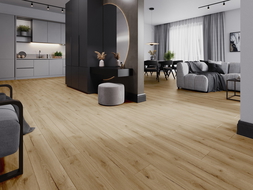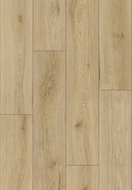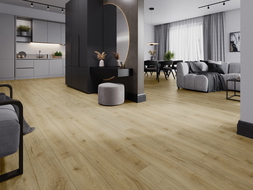
Vinyl panels are becoming an increasingly popular choice for bathroom flooring. They are especially valued because vinyl is completely waterproof. Let's not forget the exceptional aesthetic effect.
If you're in the midst of renovating or finishing your bathroom, be sure to pay attention to vinyl panels, available in a wide range of colours and patterns.
Wondering if vinyl flooring will work in your bathroom? In this article, we'll try to show that it's probably the best solution.
Vinyl panels - what exactly is this modern solution?
Vinyl floor panels are made of several layers of durable PVC (polyvinyl chloride), and their most important element is the mineral core (polymer-stone composite), which makes them water-resistant and prevents deformation when exposed to moisture.
The layered structure of vinyl panels makes them flexible and resistant to mechanical factors such as abrasion.
Advantages of using vinyl panels in the bathroom
The bathroom is a place with high humidity and temperature fluctuations, and floors and walls are prone to splashing. Therefore, when finishing the bathroom floor, it's worth opting for vinyl, a material that performs much better under these conditions than traditional laminate panels.
In the case of bathrooms, most professionals recommend only vinyl panels. Why? Here are the main arguments supporting this choice:
- Moisture resistance - Vinyl panels are waterproof, making them an ideal solution for the bathroom - even the shower. You don't have to worry about flooding the floor during a bath;
- Stain resistance - The construction of the panels means that not only water but also other substances like grease and fruit juices do not penetrate them;
- Durability - Vinyl panels have a high wear resistance. One of the newest solutions is panels with a hard core, recognised by labels like HD Mineral Core, SPC or RIGID. These stand out because they have a hard core, which is the main part of the floor. They're suitable for rooms with medium to high foot traffic;
- Ease of installation - The Uniclick system allows for DIY installation of vinyl panels, saving money on professionals. Laying the panels involves connecting the planks by sliding one into another until you hear a characteristic click, indicating proper connection;
- Anti-slip - The top layer of the panels guarantees safety, preventing slipping even when the panels are wet;
- Possibility of installation over underfloor heating - LVT panels can be confidently installed over underfloor heating. Higher temperatures do not affect the shape of the planks;
- Aesthetic appearance - Vinyl panels available at mexen.pl come in a wide selection of colours and patterns, so you'll surely find a perfect match for your bathroom design;
- Easy maintenance - Vinyl floors are very easy to keep clean, requiring only regular vacuuming and mopping with a damp cloth or mop.
As you can see, vinyl panels for the bathroom are an excellent solution that will work perfectly in your home. This type of panel is also suitable for kitchens, which are similarly exposed to moisture.
Why do vinyl panels work better than other flooring options?
Ceramic floor tiles have dominated bathrooms for many years. This solution is still used today, but more and more customers are choosing vinyl panels over tiles.
Vinyl flooring is not only more durable and resistant but also much more pleasant to touch, especially compared with cold tiles or stone flooring.
The durability of vinyl panels is just one argument for choosing them. The most important is their complete water resistance.
Easy installation is also not without significance. If you know how to install vinyl panels, you can easily do it yourself. With ceramic tiles, it's easy to make a mistake, which can negatively impact the appearance of the floor.
Can vinyl tiles be installed without chipping?
Many people associate bathroom renovation with chaos and mess, but if you choose vinyl panels for the bathroom, it may turn out that you don't need to chip away at the existing ceramic tiles on the floor.
When you choose to combine vinyl panels with underfloor heating, you can't avoid pouring an appropriate screed. In other cases, it's enough to prepare a clean and uniform surface on which to lay the panels.
On what surfaces can LVT panels be installed in bathrooms?
During a home renovation, you don't necessarily have to remove the existing bathroom floor. If you don't choose underfloor heating, the old floor covering can serve as an additional insulating layer.
This brings us to another advantage of vinyl panels, namely, you can lay them on virtually any substrate. When finishing a bathroom, this can be a classic concrete screed, and during a renovation, it can be the existing floor.
Vinyl panels can be laid on ceramic tiles, porcelain stoneware, even parquet, or wooden planks. This makes it possible to quickly and relatively easily achieve a new, elegant floor covering.
Importantly, when laying an LVT floor, it is important to use a suitable underlay. Which underlay for vinyl panels works best? Obviously, the one designed for these types of planks. A well-chosen underlay will affect their durability and acoustic properties.
Vinyl panels — aesthetics and functionality
When considering what flooring should be in the bathroom, it's also worth thinking about aesthetics. Modern technology allows vinyl panels to be adorned with almost any print or embossing. Most commonly, LVT floors mimic wood, but shades inspired by natural stone or even raw concrete colours are also available.
Using vinyl panels in the bathroom is not just about aesthetics, but also functionality. In the bathroom, panels with an anti-slip surface ensure total safety, even if the floor is wet.
Why are vinyl panels better than traditional floor panels?
Vinyl panels are an excellent alternative to traditionally used floor panels. It is a durable, high-quality product that closely resembles natural planks. Traditional panels cannot always be used with underfloor heating and often deform under the influence of water.
Many people emphasise that vinyl panels are very pleasant to the touch, and a floor laid with vinyl gives a warm feeling similar to that of natural wood. Laminated panels, ceramic tiles, and other materials used in bathrooms are noticeably colder to the touch.
Are vinyl panels suitable for the bathroom? Summary
Bathroom renovation is a real challenge that requires making many important decisions. One of them is the choice of floor and wall coverings. Today, previously used solutions such as ceramic tiles or linoleum are being abandoned, not to mention wooden floors, which are unsuitable for bathrooms due to their absorbency.
Among modern solutions, vinyl panels undoubtedly take the lead. This modern material allows you to create a bathroom floor that is not only aesthetic but also very comfortable to use.
In summary, let's list once more the most important practical features of vinyl floors:
- Water resistance - Vinyl panels are completely resistant to water;
- Resistance to mechanical factors such as abrasion;
- Elegant appearance - Vinyl panels come in a very wide range of patterns and colours;
- Compatibility with underfloor heating - Vinyl floor panels perfectly conduct heat;
- Easy installation - Both click-lock and glued panels can be laid independently;
- Ease of cleaning - Vinyl flooring only needs to be washed with warm water and a regular detergent - there's no need for scrubbing, waxing, etc.
Vinyl panels are a modern and functional solution - they allow for creating stylish interiors, and changing the floor can prove to be quite simple without the need for removing ceramic tiles.
If you're looking for the right material to finish your bathroom, be sure to check out the full range of vinyl floor panels available in our online store.


